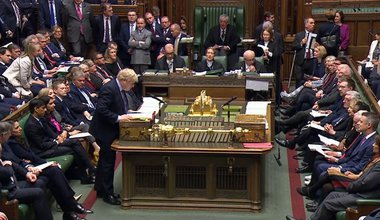
Towards virtual parliaments?
This corona crisis may yet be an incentive for policy makers to embrace technological approaches and develop a culture of experimentation.

Just as commentators began to warn that the COVID-19 pandemic might develop into a “disaster for democracy”, we are witnessing the “most drastic and substantive modernising of how parliament functions in living memory.” Often criticised as supine, slow, and historically risk averse, parliaments in many countries are displaying remarkable flexibility and determination. They are recalibrating the power imbalances that the fight against the pandemic has brought to the branches of government.
Unable to physically convene, dozens of parliaments have put in place measures for virtual sittings. Virtual parliaments are crucial to continuing to hold their governments to account, whose extensive use of emergency powers has led to historic constraints on democratic rights and liberties. This enables parliaments to maintain some form of democratic scrutiny and legislative function, to uphold public trust and the rule of law. These measures also provide an extraordinary testbed for the use of technology in parliament.
Digital parliaments are born?
Security and reliability are a major source of concern. Indeed, new technology and novel applications can produce new threats. Some countries have been fast to install or upgrade authentication of elected members for remote voting. Moreover they have adopted additional security controls and mitigation strategies, to ensure the safety of virtual public sittings.
Yet there are also growing concerns surrounding the vulnerability to hackers controlling and manipulating the system, alongside foreign surveillance and so-called “Zoom bombing”. Incidents like politicians accidentally tweeting meeting IDs have also emphasised the particular security risks that comes from users (pilot error) and not from technology. There is much to learn from early adopters in e-government, such as Estonia, which has become a world leader in cyber security after a distributed denial of service attack paralysed government agencies in Estonia in 2007.
We’ve got a newsletter for everyone
Whatever you’re interested in, there’s a free openDemocracy newsletter for you.
But the ad hoc manner in which a wide range of technological tools are being implemented at the moment emphasises the need for long-term investment. Such services need to provide reliable security measures, ranging from the improvement of tech support in political institutions, to routine cyber drills, and to security training for politicians.
Parliaments have also rushed through amendments to procedural rules, allowing the accommodation of remote sittings and voting. In many countries such as in Australia, The Republic of Ireland and Chile, online sittings also raise constitutional questions. For example, what does it mean if the constitution defines a specific "place" for the parliament to sit or requires the "’presence’ of members"? For now, makeshift amendments and purposive constitutional interpretation may address these challenges. Clearly comprehensive reforms, that guarantee parliamentary privileges and allow meaningful debate in an online environment, is required in the long run.
Deliberative challenges
Perhaps most importantly, online sittings fundamentally change parliamentary debating practice, particularly for debate-heavy parliaments, such as those of the UK. Last week’s first semi-virtual Prime Minister’s Questions on the government’s COVID-19 responses had none of the usual “jibes, the roaring and the heckling”, with some MPs celebrating the experiment as a sign of a “grownup democracy, sensible and pleasingly boring.” This may have been due to the seriousness of the topic discussed, but virtual parliament debates will invariably be more formalised, less spontaneous, perhaps leading to more rational sittings.
Whether they are also more effective, remains to be seen. The flow of virtual debates in various parliaments was disrupted by technical glitches, unreliable internet connections, or hapless slip-ups by unwary politicians. More importantly, academic research on online deliberation suggests that virtual environments may have limitations in communicating rich emotions through non-verbal cues and needs to be carefully designed to be productive.
EU Parliamentarians are already expressing the difficulties that come with the absence of a physical ‘common’ social space for deliberating, consensus-building, and decision-making. This may also impact the public function of parliamentary debates – after all, lively parliamentary exchanges are also a means to communicate different rationales of decision-making to the public. With hours of virtual parliament sessions from all over the world currently accumulating online, researchers now have ample empirical material to go through such aspects in detail.
So, what will stick after the crisis is weathered? The turn to digital tools may very well spur welcome changes in parliamentary practice that have been looming for a while. The availability of video conferencing and proxy voting could improve accessibility for MPs in faraway constituencies, for those on parental leave or with disabilities, or even reduce gender inequalities; it could ease the more formal and topic-specific work of parliamentary committees.
Virtual sittings may be considered a temporary option in the UK, where the restoration and renewal of the historic Parliament building would otherwise require parliamentarians to convene at a different venue. But as of now, virtual parliaments have too many limitations to replace face-to-face parliamentary debates.
As of now, virtual parliaments have too many limitations to replace face-to-face parliamentary debates.
Corona as a catalyst for a broader digital strategy for parliaments
It may be worthwhile using the current surge of technology for a broader and more nuanced re-think of how technology can help to reconnect parliaments with those whom they are supposed to represent: the people. Citizens and parliaments remain apart in important ways. The digital era has transformed the way our societies work but democratic institutions have largely remained untouched by technology. There is a gap between the people and the political class, and institutions are struggling to channel increasingly individualised, ad hoc and single-issue-driven political activism, contributing to a decline in trust and confidence in governments. In the long term, this may be the real, if more subtle, “threat to democracy”.
Democratic institutions have largely remained untouched by technology.
Political institutions will need to innovate or otherwise be left behind. This requires reforms across the spectrum of digital tools, from planning and back‐end systems to open data – and perhaps most importantly – to citizen engagement. There are now hundreds of tools and platforms designed to improve the quality, legitimacy and transparency of decision-making: visualisation tools, such as K-Monitor in Hungary or parliamentary monitoring websites, such as TheyWorkForYou in the UK, have done much to improve the transparency and accessibility of parliamentary processes and the accountability of politicians.
Local experiences with citizen participation platforms, such as Consul, show that productive collaborative approaches to policy making are possible. Gradually, similar tools are being implemented at the national level, such as Parlaments & Citoyen in France or the e-Democracia portal in the Brazilian Chamber of Deputies.
These examples show that digital tools have the potential to open up new channels for productive and substantial two-way dialogue between citizens and their representatives is possible.
Technology will require political will and buy-in from decision-makers, and an openness for experimentation – this is what has been missing for a long time.
To be clear, technology is only a tool, not a panacea and it comes with its own problems. Much work still needs to be done to understand how digital tools impact on different groups in society, where they may increase digital divides, or produce unintended biases. The adoption of digital tools needs to be holistically planned and gradually implemented, they need to be targeted, and carefully designed to run productively alongside and support existing institutions rather than supplanting them. This will require resources, changes to traditional working patterns in institutions, and structural reforms of existing processes.
Most importantly, technology will require political will and buy-in from decision-makers, and an openness for experimentation – this is what has been missing for a long time. The current tide of technological impetus should be used to take the opportunities that technology offers seriously and identify avenues towards a democracy which is more open, collaborative and interactive. If there is one good thing that may come from this crisis, in terms of modernising the parliamentary status quo, it may be as an incentive for policy makers to embrace technological approaches and to develop this culture of experimentation.
Read more
Get our weekly email




Comments
We encourage anyone to comment, please consult the oD commenting guidelines if you have any questions.